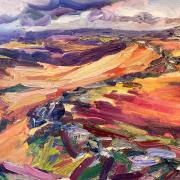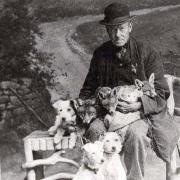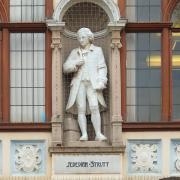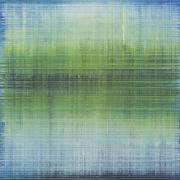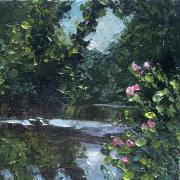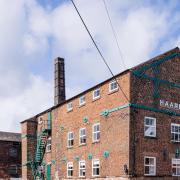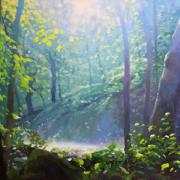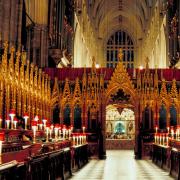Mike Smith visits Derbyshire artist Leigh Cooke, whose designs grace the products of famous fashion houses Hermés and Ferragamo
During the last weekend in November, the fabulous conservatory at Thornbridge Hall will be the venue for an exhibition curated by Derwent-Wye Fine Art of exquisite pictures by Leigh Cooke, an artist who is responsible for several designs which feature on one of the most sought-after fashion items produced by Herm�s. The French luxury goods and high-fashion house has a huge product range which includes men’s wear, women’s wear, perfume, watches, stationery, footwear, gloves, tableware, ceramics and, not least, silk scarves of the very finest quality. A silk scarf by Herm�s is sold somewhere in the world every 25 seconds, and many of those scarves carry highly original and distinctive designs by Leigh Cooke.
I was privileged to visit Leigh in his studio as he prepared for his solo exhibition. Lest readers imagine that my visit was made to a state-of-the-art studio space in the Rue du Faubourg Saint-Honor� in Paris, where the celebrated fashion house has its headquarters, I should explain that the artist produces his designs for Herm�s in a most unlikely location. Leigh’s studio stands in the grounds of Thornbridge Hall, near Ashford in the Water, where the owners, Jim and Emma Harrison, have provided him with the use of a small former chapel, which is clad in corrugated iron and is known as the Tin Tabernacle.
The little door of the building, which is topped by a Hebrew inscription, opens into a pure-white room. A set of shelves on the far wall holds scores of gift boxes containing luxury products produced by Herm�s and by Salvatore Ferragamo, all of which feature Leigh’s designs. Several table-tops in the room and various parts of the floor are obscured by large white sheets of card, some adorned with finished designs or completed paintings, others with works in progress.
Two of those white sheets of card caught my eye as I entered the studio. One was covered in coat-hangers arranged at various angles. I was almost tempted to pick up one of the hangers and use it to store my jacket until I realized that I was actually looking at a large painting that was so unbelievably photo-realist that it was necessary to touch the hangers to check whether or not they were real. The other card that attracted my attention was a blank sheet littered with real objects, including a pair of black shoelaces, a cork, a small spring, a nail, a feather, a painted cube from a child’s picture puzzle, a piece from a jigsaw and a tiny strip light.
Noticing my curiosity, Leigh said: ‘To my eyes, all those different objects are connected in some way by their patterning, colour, texture and form. I intend to arrange them so that they will be sufficiently separated to retain their own identity but close enough to remain on friendly terms with their neighbour. It might take me four or five weeks to the place them on the card until I am satisfied that the arrangement will give me the basis for a painting. I liken the process to composing a symphony.’
On another table, Leigh had laid out a scarf called A Vos Crayons which has become a Herm�s classic. Its wide border is patterned with depictions of pencils, carefully arranged according to their various colours, and its central square is covered with paintings of the curly shavings that were produced when the pencils were sharpened. Leigh had placed on top of the scarf a small box containing the very pencil shavings he had used as models for his painting. His design is so realistic that the depictions of shavings look as if they are real shavings that have spilt out of the box and onto the material.
The story of Leigh’s progress from unsuccessful school pupil to leading designer is quite remarkable. His start in life was far from ideal: he was one of eight children; his father left home when he was eleven years old and he suffered so badly from dyslexia that he was written off by most of the teachers at his school in Long Eaton. However, his talent was recognized by his art teacher Jo Beattie, who encouraged him to pursue his studies at college. Unfortunately, he was unable to take up a provisional place at the prestigious Slade School of Art because he was unable to obtain the necessary O-level qualifications.
After eleven years in employment as a sign printer, Leigh managed to obtain a place as a mature student at Manchester Metropolitan University. His degree show three years later attracted the attention of John Miles from the Royal Academy of Arts, who was bowled over by the ‘quirkiness and odd compositional feel of the work’. This recognition led to the inclusion of his work in the New Designers’ Show in Islington and in the Text Print Exhibition in Baker Street, where he won the Pantone Inc. View of Colour Award for his ‘brilliant sense of colour; real individuality and originality’.
The luxury goods house of Salvatore Ferragamo snapped him up as a designer and commissioned work from him throughout the following five years. In 2001, he obtained his first commission from Herm�s, who continue to use his designs on scarves and ceramics. Incredibly, his work for two of Europe’s leading fashion houses was produced in the tiny attic or on the kitchen table of his home in Calver until he moved his operations to the Tin Tabernacle Studio.
Some of Leigh’s work is based on items picked up on his many trips abroad, particularly objects and plants that have caught his eye in India and Japan, but many of his other designs are based on objects found closer to home. For example, a scarf called Winter Walk is a depiction of natural objects collected during a stroll near his house. He says, ‘I never switch off from my work, even when I’m on holiday with my family, because I’m always on the look-out for objects that will come together to form a collective.’
As well as producing designs for Herm�s, Leigh teaches textile design at Northampton and chairs the hanging committee for the annual Text Print shows. His work has been shown in exhibitions by Herm�s in Shanghai and Italy; it also features in Le Carr� Herm�s, a beautifully illustrated book written by Nadine Coleno.
However, Leigh’s art is now entering a new phase. Although he continues to respond to design commissions, he is also working as a self-directed artist by embarking on a series of colourful and beautifully detailed paintings. Some of this new work will be shown during the last weekend in November at Thornbridge Hall, before transferring to the Abbey Walk Gallery in Grimsby in 2012.
Thanks to a grant from the Arts Council, Leigh is also being given assistance in preparing other up-coming solo shows, beginning with an exhibition in 2012 at Paul Smith’s showroom in Mayfair.
Three-dimensional effects on two-dimensional surfaces are a feature of all Leigh’s work. These are achieved by the meticulous application of layer upon layer of watered-down acrylic paint. The success of this technique was made evident to me yet again as I made for the exit of the Tin Tabernacle and spotted three matches arranged on top of a small advertisement from Caff� Nero. Unable to resist making a reality check by touching the matches, I discovered that they were actually trompe l’oeil images painted by Leigh, an artist with an uncanny ability to juxtapose objects in a meaningful way and represent them with vivid realism.





